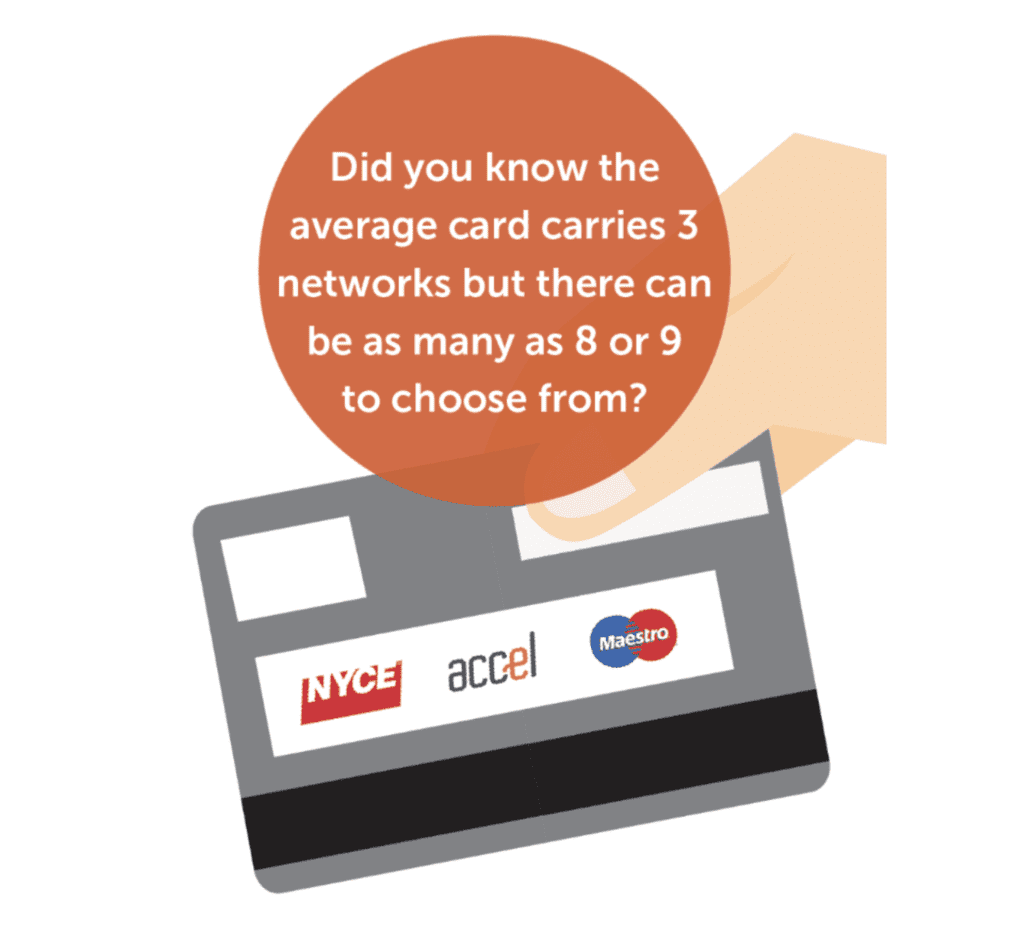PIN Debit Networks – The Ultimate Guide
When accepting debit cards, especially PIN-based debit cards, there’s always more than meets the eye. It’s more than just your credit card processing discount rate or per transaction fee that come into play.
Peeling back the layers of credit card processing, below we discuss how PIN-based debit card routing works and how your business can optimize savings on your credit card merchant fees.
What is a PIN Debit Network?
A PIN debit transaction occurs when a customer pays with a debit card and enters their PIN number associated with the debit card. A PIN debit transaction only applies to retail companies or brick and mortar businesses accepting debit cards face to face.
Thanks to the Durbin Amendment, associated with the 2010 Dodd-Frank Act, there’s a cap on PIN debit interchange rates that merchants are charged by the card networks. The Durbin Amendment developed regulatory provisions that directly affect debit interchange rates, debit network processing, and merchant payment acceptance options.
It was meant to cut costs for consumers, as retailers could drop their prices because they would be paying less to the banks for debit card transactions. However, because big banks lost billions of dollars on this, they decided to hike fees, add surcharges, and down grade interchange rates for merchants.
These provisions were designed to favor, assist, and even out the playing field for merchants, especially larger organizations that have a significant amount of debit card transactions.
The Durbin Amendment is supposed to give merchants the choice of which debit card network they want to route their credit card processing transactions on and requires issuers (credit card processor) to offer at least two debit network options to its customers.
Why does this matter to you as a merchant? It matters because ultimately your credit card processing company could be charging you tens of thousands of additional dollars a month because they are incorrectly routing your pin debit transactions.

Debit Card Routing Paths Explained
There are two ways to route debit card transactions. The routing paths for each of these vary, which will affect your fees. You could be paying too much for debit card processing if you’re using a non-optimal method.
PIN Debit Routing
Cardholders use a personal identification number (PIN) to complete a debit card transaction.
This processing method goes through a PIN debit network for routing. For PIN debit routing, the transaction bypasses Visa or Mastercard’s network. As a result, interchange fees from these card networks will not apply to your transaction.
Instead, the PIN network fees will be imposed. PIN networks typically have low percentage fees, but higher fixed fees for each transaction. Due to this pricing structure, low-ticket purchases are more expensive for merchants.
For example, let’s say you run a local or national coffee chain. $2 transactions would not be optimal for PIN-based debit card routing.
Signature Debit Routing
Unlike PIN debit routing, a signature debit transaction will get processed through a card network. Customers verify these transactions with their signature, hence the name.
You can compare a signature debit transaction to traditional credit card processing. That’s because they’ll be routed the same way through a processor and card network. With that said, there are still differences between credit and debit transactions.
PIN networks do not have a role in processing a signature debit card. But these transactions are subject to interchange fees imposed by the appropriate card network.
The signature debit processing fees are significantly lower than a standard debit card transaction. That’s because there is far less risk associated with these transactions. The issuing bank does not have to extend any credit. Money is deducted straight from the cardholder’s checking account.
PIN Debit Network Processing Fees For Debit Cards
Thanks to the Durbin Amendment, the debit network market in the US is fairly competitive. Debit routing through domestic debit networks for unregulated card issuing banks aren’t subject to the maximum allowed fee under federal law. But most consumer debit cards don’t fall into that category.
Credit and debit cards both need to go through your processor. The exact cost you’ll pay for each pin transaction will vary. Some factors include:
- Online transactions vs. offline debit transactions
- Interchange network fees
- Signature debit transaction (or pinless debit)
- Transaction volume
- Card brands
We have a complete guide on PIN vs. Signature debit that explains these costs in greater detail.
What Credit Card Processors Don’t Want You to Know
Most retail merchants claim that their credit card processing company is routing their PIN debit transactions to the correct network to “optimize” the interchange rates that would benefit the merchant.
For example, First Data leverages “smart routing technology”, which is an algorithm that allegedly routes pin debit transactions to the most cost effective network.
What most merchants do not realize is that many credit card processing companies own or have an existing partnership with the debit card networks. Due to this, they push the pin debit volume of their merchants to the network they own or get the most financial benefit from.
To see the existing relationships between credit card processors and the PIN debit networks, let’s take a closer look at who owns some of the most popular debit card networks:
- Interlink — owned by Visa
- Maestro — owned by Mastercard
- Pulse — owned by Discover
- Star — owed by First Data
- NYCE/AFFN — owned by FIS
- Accel — owned by Fiserv
- Jeanie — owned by Vantiv
- Alaska Option — owned by an independent provider
- Culiance — owned by an independent provider
- Shazam — owned by an independent provider
All of these ten debit networks are owned by either card network or precursor. You can imagine where this can cause some conflict of interest.
If a credit card processing company is routing debit card transactions to the network they own, it does not mean that your business is getting the most cost effective option. 40-50% of debit cards prior to 2010 only had one routing debit network option. For retailers, this hand tied their business because there was no other options, the interchange fees were the interchange fees.
Today, the average number of debit card networks associated with a debit card is three.
Due to the No Network Exclusivity Clause of the Durbin Amendment, each debit card is required to have a minimum of two debt card networks where they can be routed. Some debit cards have up to nine debit card networks to route to which ultimately gives options to optimize and find more cost effective networks.
Is Your Processor Routing Debit Transactions Correctly?
There are a few reasons why your credit card processing company is not optimizing your pin debit transactions:
- Outdated Routing Solutions – Many credit card processing companies do not have up to date software to route your pin debit transactions correctly. This exposes your business to higher interchange fees, leaving up to 25 basis points of further savings your business could incur.
- Outdated Routing Tables – Credit card merchant providers need to update their interchange tables as new interchange rates become available. Interchange fees and switch fees change periodically and maintaining good visibility will help keep your credit card processing company honest and accurate.
- High Credit Card Merchant Fees – Some credit card processing companies will charge high credit card merchant fees to route and optimize your pin debit transactions. Typically, it is a per transaction or authorization fee that they charge every time a card is routed. Credit card processors will use this to make up the difference in the savings they obtain to earn money back.
- Conflict of Interest – Some credit card processing companies have direct relationships or own some of the debit card networks, which causes them to act in their own best interest instead of yours.
Incentive agreements are put in place with credit card processors and the debit networks where the credit card processing company needs to put a certain volume threshold through a certain network to gain a financial advantage against their competition.
How to Optimize Debit Card Routing
Most merchants are under the assumption that their routing systems are optimal. That’s because credit card processors have sold them on the concept of dynamic routing.
However, if you take the time to truly assess your debit card processing, you’ll quickly discover there are ways to save money.
For a merchant, optimal debit card routing means that you’re using the most cost-effective solution. But your debit card processing fees will vary based on a wide range of factors.
Make Sure Your Processor is Routing Debit Transactions Correctly
There are a few reasons why your credit card processing company is not optimizing your pin debit transactions:
- Outdated Routing Solutions – Many credit card processing companies do not have up to date software to route your pin debit transactions correctly. This exposes your business to higher interchange fees, leaving up to 25 basis points of further savings your business could incur.
- Outdated Routing Tables – Credit card merchant providers need to update their interchange tables as new interchange rates become available. Interchange fees and switch fees change periodically and maintaining good visibility will help keep your credit card processing company honest and accurate.
- High Credit Card Merchant Fees – Some credit card processing companies will charge high credit card merchant fees to route and optimize your pin debit transactions. Typically, it is a per transaction or authorization fee that they charge every time a card is routed. Credit card processors will use this to make up the difference in the savings they obtain to earn money back.
- Conflict of Interest – Some credit card processing companies have direct relationships or own some of the debit card networks, which causes them to act in their own best interest instead of yours.
Incentive agreements are put in place with credit card processors and the debit networks where the credit card processing company needs to put a certain volume threshold through a certain network to gain a financial advantage against their competition.
Remember No Network Exclusivity (NNE)
The Durbin amendment of 2011 had a clause for No Network Exclusivity (NNE).
This clause was enacted to entice competition between card networks. It guaranteed that each debit card must have at least two mutually exclusive debit networks. Merchants have the ability to route PIN debit transactions at competitive rates. That’s because there are more options in the industry, as opposed to a monopoly of just one network per card.

Consider Payment Processor Incentives
All PIN routing will still go through your payment processor. But your credit card processing company might have relationships with specific debit card networks.
In these cases, payment processors have an incentive to route the transaction based on what’s financially optimal for them—not for the merchant.
Payment processors could receive a higher percentage or bonus based on the volume of PIN debit transactions routed through a particular network. But you could potentially save money on debit card sales if those same transactions were routed elsewhere.
In some cases, there might be a clause in your credit card processing contract that does not oblige the processor to optimally route debit transactions in your favor. So essentially, they have free rein to do whatever they want.
Evaluate Your Own Incentive Agreements With Networks
Larger merchants and enterprises are often able to negotiate their own terms with debit networks. In these cases, it’s common for a network to offer you a large sum of cash upfront to prioritize their network for PIN debit routing.
While a big check can be tempting, take the time to weigh the true cost of this agreement.
This short-term gain could end up costing you significantly more money in processing fees in the long-run. So I’d recommend seeking an alternative incentive agreement if you’re presented with this offer.
Avoid Unregulated Interchange Fees
Earlier, we talked about the Durbin amendment. But not every transaction applies to these regulations.
According to the latest data from the US Federal Reserve, roughly 38.2% of debit transactions are exempt from the Durbin amendment. This explains why those interchange fees haven’t dropped. Here’s a look average interchange fees by year:

Take a look at the red dotted line in this graph. This is for duel-message networks and exempt transactions.
Those interchange fees remain high, even after the Durbin Amendment went into effect in 2011. As you can see, the average rate has been slowly rising over the last few years and is trending upward.
Final Thoughts on PIN Debit and Optimizing Debit Card Routing
Optimal debit card routing is a complex subject. A payment processor cannot simply view a table of various network fees to find the most cost-effective route for merchants. There are lots of other factors at play.
The reality here is that the most cost effective route for pin debit transactions has multiple factors, including the network availability, the MCC code of the merchant (type of business), transaction amount, and regulation status (unregulated or regulated pin debit).
Do not rely on the word of your credit card processor as they typically do not have your best interest in mind. Instead, look into auditing these transactions to ensure you are saving the most amount of money is a better alternative.


0 Comments